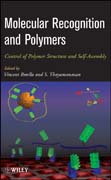
Molecular recognition and polymers: control of polymer structure and self-assembly
Rotello, Vincent
Molecular Recognition and Polymers covers the fundamental aspects and applications of molecular recognition in the creation of novel polymeric materials for use in drug design and delivery, sensors, tissue engineering, and other areas. It provides examples of how supramolecular strategies can be used in the creation and self-assembly of polymers and covers state-of-the-art techniques for the design and characterization of non-covalent interactions in polymers in order to tailor the material's properties to various applications. This is a great reference for graduate students and researchers in related fields. INDICE: List of Tables, Figures, Charts and Schemes. Dedication. Preface. Acknowledgements. Editor Bibliographies. List of Contributors. PART I: FUNDAMENTALS OF SUPRAMOLECULAR POLYMERS1 . 1. A Brief Introduction to Supramolecular Chemistry in a Polymer Context1 (Raymond J. Thibault and Vincent M. Rotello). 1.1 Introduction and Background1. 1.2 Main-chain versus Side-chain Supramolecular Polymers. References. 2. Molecular Recognition Using Amphiphilic Macromolecules (Malar A Azagarsamy, K. Krishnamoorthy, and S. Thayumanavan). 2.1 Introduction. 2.2 Amphiphilic Block Copolymers. 2.2.1 Non-Specific Interactions. 2.2.2 Specific Interactions. 2.3 Amphiphilic Homopolymers. 2.3.1Container Properties. 2.4 Amphiphilic Dendrimers. 2.5 Conclusions. 2.6 Acknowledgements. References. 3. Supramolecular Control of Mechanical Properties in Single Molecules, Interfaces and Macroscopic Materials (David M. Loveless, Farrell R. Kersey andStephen L. Craig). 3.1 Introduction and Background. 3.2 Mechanical Propertiesof Linear Supramolecular Polymers. 3.3 Mechanical Properties of Supramolecular Polymer Networks. 3.4 Mechanical Properties in Supramolecular Polymers at Interfaces. 3.5 Mechanical Forces and Supramolecular Interactions. 3.6 Conclusions. References. PART II: POLYMER FORMATION AND SELF-ASSEMBLY. 4. Hydrogen BondFunctionalized Block Copolymers and Telechelic Oligomers (Brian D. Mather andTimothy E. Long). 4.1 Scientific Rationale and Perspective. 4.2 Hydrogen Bonding Interactions in Macromolecular Design. 4.2.1 Fundamentals of Hydrogen Bonding. 4.2.2 Performance Advantages of Hydrogen Bond Containing Polymers. 4.3 Hydrogen Bond Containing Block Copolymers. 4.4 Telechelic Hydrogen Bond Functional Polymers. 4.5 Combining Hydrogen Bonding with other Non-Covalent Interactions. 4.6 Reversible Attachment of Guest Molecules via Hydrogen Bonding. 4.7 Conclusions and Summary. References. 5. Non-Covalent Side-chain Modification (Kamlesh P. Nair and Marcus Weck). 5.1 Introduction. 5.2 Strategies Towards Noncovalent Side-Chain Functionalization of Polymeric Scaffolds. 5.3 Noncovalent Multifunctionalization of the Side-Chains of Polymeric Scaffolds. 5.4 Applications of Noncovalently Functionalized Side-Chain Copolymers. 5.5 Conclusions and Outlook. 5.6 Acknowledgements. References. 6. Polymer-Mediated Assembly of Nanoparticles Using Engineered Interactions (Hung-Ting Chen, Yuval Ofir, and Vincent M. Rotello). 6.1 Introduction. 6.2 Design of Nanoparticles and Polymers. 6.3 Self-Assembly Polymer-particle Nanocomposites. 6.4 Conclusions and Outlook. References. 7. Metallo-Supramolecular Polymers, Networks, and Gels (Blayne M. McKenzie and Stuart J. Rowan). 7.1 Introduction. 7.2 Metal-Ligand Binding Motifs. 7.3 Linear and Macrocyclic Main-Chain Metallo-Supramolecular Polymers. 7.4Metallo-Supramolecular Networks and Gels. 7.5 Conclusion and Outlook. References. 8. Polymeric Capsules: Catalysis and Drug Delivery (Brian P. Mason, Jeremy L. Steinbacher, and D. Tyler McQuade). 8.1 Introduction. 8.2 Methods of Encapsulation. 8.3 Catalyst Encapsulation. 8.4 Drug Delivery with Microcapsules. 8.5 Conclusion. References. 9. Sequence-Specific Hydrogen-Bonded Units for Directed Association, Assembly and Ligation (Bing Gong). 9.1 Introduction. 9.2 General Design: Information-Storing Molecular Duplexes Based on the Recombinationof H-Bond Donors and Acceptors. 9.3 Quadruply H-Bonded Duplexes with Sequence-Independent Stability. 9.4 Tuning Binding Strength by Varying the Number of Interstrand H-Bonds. 9.5 Probing Sequence-Specificity. 9.6 Unexpected Discovery: Duplexes Containing Folded Strands. 9.7 Directed Assembly: Formation of -sheets and Supramolecular Block Copolymers. 9.8 Integrating Non-covalent and Covalent Interactions: Directed Olefin Metathesis and Disulfide Bond Formation. 9.9 Conclusions and Future Perspective. 9.10 Acknowledgements. References. 10. Bio-Inspired Supramolecular Design in Polymers for Advanced Mechanical Properties (Zhibin Guan). 10.1 Introduction. 10.2 Biomimetic Concept of Modular Polymer Design. 10.3 Results and Discussion. 10.4 Summary and Perspective. 10.5 Acknowledgements. References. 11. The Structure and Self-Assembly of Amphiphilic Dendrimers in Water (Hui Shao and Jon R. Parquette). 11.1 Introduction. 11.2 Structure. 11.3 Self-Assembly and Aggregation. 11.4 Folded Amphiphilic Dendrimers. 11.5 Langmuir-Blodgett Monolayers. 11.6 Conclusion. References. PART III: BIOMOLECULAR RECOGNITION USING POLYMERS. 12. Colorimetric Sensing and Biosensing Using Functionalized Conjugated Polymers (Amit Basu). 12.1 Introduction. 12.2 Polydiacetylene. 12.3 Polythiophenes. 12.4 Other Materials. 12.5 Summary. References. 13. Glycodendrimers and Other Macromolecules Bearing Multiple Carbohydrates (Mary J. Cloninger). Abstract. 13.1 Introduction. 13.2 Dendrimers to Glycodendrimers. 13.3 Multivalency. 13.4 Heteromultivalent Carbohydrate Systems. 13.5 Comments Regarding the Synthesis of Heteromultivalent Carbohydrate Systems. 13.6 EPR Characterization of Heterogeneously Functionalized Dendrimers. 13.7 Conclusions and Outlook. 13.8 Acknowledgement. References. 14. Supramolecular Polymerization of Peptides and Peptide Derivatives: Nanofibrous Materials (He Dong, Virany M. Yuwono, and Jeffrey D. Hartgerink). 14.1 Introduction. 14.2 Self-Assembly of Nanofibers Based on Alpha-Helices. 14.3 Nanofibers Self-Assembled from Beta-Sheets. 14.4 Collagen Mimetics. 14.5 Conclusions. References.15. Molecular Imprinting for Sensor Applications (Xiangyang Wu and Ken D. Shimizu). 15.1 Introduction to Sensing Platforms. 15.2 Synthesis of Molecularly Imprinted Polymers. 15.3 Recognition Properties of MIPs. 15.4 Polymer Formats and Morphologies. 15.5 Application of MIPs in Sensing. 15.6 Conclusions and Outlook. References. Index.
- ISBN: 978-0-470-27738-6
- Editorial: John Wiley & Sons
- Encuadernacion: Cartoné
- Páginas: 488
- Fecha Publicación: 19/09/2008
- Nº Volúmenes: 1
- Idioma: Inglés
